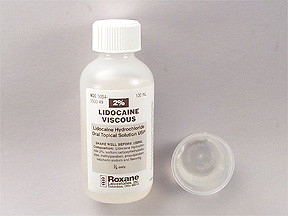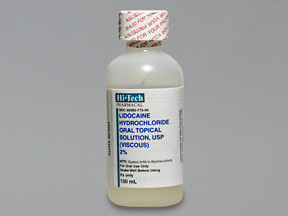LIDOCAINE VISCOUS - ORAL
PHONETIC PRONUNCIATION: (LYE-doe-kane)
COMMON BRAND NAME(S): Xylocaine Viscous
GENERIC NAME(S): lidocaine HCl
Uses
USES: See also Warning section. Viscous lidocaine is used to relieve pain and discomfort from a sore throat/mouth. It is also used to numb the lining of the mouth and throat before certain medical/dental procedures (such as dental impressions). This numbing helps prevent the urge to close the throat (gag reflex), which might make the procedure more difficult. Lidocaine belongs to a class of drugs known as local anesthetics.
How to use LIDOCAINE VISCOUS - ORAL
HOW TO USE: Read the Patient Information Leaflet if available from your pharmacist before you start using lidocaine and each time you get a refill. If you have any questions, ask your doctor or pharmacist. Shake the bottle well before each dose. Carefully measure the dose using a special measuring device/spoon. Do not use a household spoon because you may not get the correct dose. Do not mix with other liquid or food unless directed by your doctor. Use this medication as directed by your doctor, usually as needed for pain or soreness. For mouth pain, swish the dose in your mouth, then spit out. To treat a sore throat, gargle with the medication, then swallow or spit out, as directed by your doctor. To treat irritation of the esophagus, swallow the dose as directed by your doctor. Children should not swallow this medication unless directed by their doctor. The dosage is based on your medical condition and response to treatment. In children, the dosage is also based on age and weight. Do not increase your dose or use this drug more often or for longer than prescribed, because your risk of side effects will increase. Overdose has occurred in children accidentally given the wrong dose. According to the US manufacturer, do not give a child more than 4 doses in a 12-hour period. According to the Canadian manufacturer, do not give a child more than 4 doses in a 24-hour period. In adults, the usual maximum dose is 15 milliliters per dose. According to the US manufacturer, adults should not use this medication more often than every 3 hours and should not use more than 8 doses in a 24-hour period. According to the Canadian manufacturer, adults should not use more than 6 doses in a 24-hour period. Follow your doctor's instructions carefully. For infants and children younger than 3 years, carefully measure the prescribed dose and apply to the affected area with a cotton swab. Wait at least 3 hours before giving the next dose. See also Warning section. This medication numbs the mouth and throat. Numbness may make swallowing difficult and increase your risk of swallowing the wrong way or choking. Do not chew gum or eat for 1 hour after using this product and while your mouth or throat is numb. It is especially important for children to not eat or chew gum for at least 1 hour after using this product. Be careful not to accidentally bite your tongue or mouth. Lidocaine starts to numb the affected area within 5 minutes after use. If you are using this product before certain procedures, tell your doctor if the area does not feel numb or the numbness does not go away. If you are using this product to relieve pain/discomfort, tell your doctor if your condition lasts or gets worse.
Side Effects
Precautions
Interactions
Overdose
Images
Reviews
Faq for LIDOCAINE VISCOUS - ORAL
Lidocaine Viscous is used to treat pain and discomfort in the mouth and throat, such as toothache, sore gums, and canker sores.
Lidocaine Viscous works by numbing the affected area, providing temporary relief from pain and discomfort.
Lidocaine Viscous should be used as directed by your healthcare provider. It is usually applied to the affected area with a swab or sprayed onto the affected area. You should not swallow the medication.
Common side effects of Lidocaine Viscous may include a bitter taste, numbness of the mouth or throat, dizziness, and nausea. Rare but serious side effects may include allergic reactions and difficulty breathing.
Lidocaine Viscous can be used by children but should be used under the guidance of a healthcare provider, as the dosage may vary based on the child's age and weight.
Lidocaine Viscous should only be used during pregnancy or breastfeeding if recommended by a healthcare provider, as it may pass into breast milk or affect the baby.
The duration of the numbing effect of Lidocaine Viscous may vary, but it is usually effective for about 30 minutes to 2 hours.
Lidocaine Viscous may interact with certain medications, such as antiarrhythmics or other local anesthetics. It is important to inform your healthcare provider about all the medications you are taking before using Lidocaine Viscous.
If you accidentally swallow Lidocaine Viscous, seek medical attention immediately, as it may cause serious side effects, such as seizures or heart problems.
Warning
WARNING: Use of this medication by children younger than 3 years has caused serious (sometimes fatal) side effects, including seizure and slowed/stopped heart. If this medication is prescribed for use by a child younger than 3 years, carefully follow the doctor's directions. Do not increase the dose or give this medication more often than directed. Do not use this medication to treat teething pain in infants and young children unless directed by the doctor. Talk with the doctor about other ways to treat teething pain. Keep this product in a safe place away from children.
Disclaimer
IMPORTANT: HOW TO USE THIS INFORMATION: This is a summary and does NOT have all possible information about this product. This information does not assure that this product is safe, effective, or appropriate for you. This information is not individual medical advice and does not substitute for the advice of your health care professional. Always ask your health care professional for complete information about this product and your specific health needs.



No Reviews Yet